Using IPython/Jupyter Notebook with PyCharm
Before you start
Prior to executing the tasks of this tutorial, make sure that the following prerequisites are met:
- You have a Python project already created. In this tutorial the project
C:/SampleProjects/py/JupyterNotebookExampleis used. - In the Project Interpreter page of the Settings/Preferences dialog, you have:
- Created a virtual environment. For this tutorial a virtual environment based on Python 3.6 has been created.
- Installed the following package:
Note that PyCharm automatically installs the dependencies of these packages.
Creating a Jupyter Notebook file
In the Project Tool Window, click Alt+Insert. Then, on the pop-up menu that appears, choose the option and type the file name (here it is MatplotlibExample.ipynb).
The newly created file now shows up in the Project Tool Window and automatically opens for editing.
By now, the new file is empty, but PyCharm recognizes it as a notebook file. As such, this file is marked with the icon ![]() and features a toolbar, which is a complete replica of the real Jupyter Notebook toolbar:
and features a toolbar, which is a complete replica of the real Jupyter Notebook toolbar:

Filling in and running the first cell
This is most easy. Just click the first cell and start typing. For example, in the very first cell type the following code to configure the matplotlib package:
%matplotlib inlineNext, click the icon ![]() to run the cell (alternatively, you can press Shift+Enter). PyCharm shows a dialog box, where you have to specify the URL where the Jupyter Notebook server will run:
to run the cell (alternatively, you can press Shift+Enter). PyCharm shows a dialog box, where you have to specify the URL where the Jupyter Notebook server will run:

In this dialog box, click Cancel, and then click the Run Jupyter Notebook link:
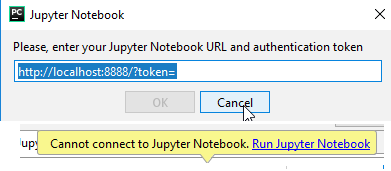
Next, if you didn't install the "Jupyter Notebook" package yet, the run/debug configuration dialog appears showing the error message:

Install the package to fix the problem.
Jupyter server runs in the console:

Follow this address:
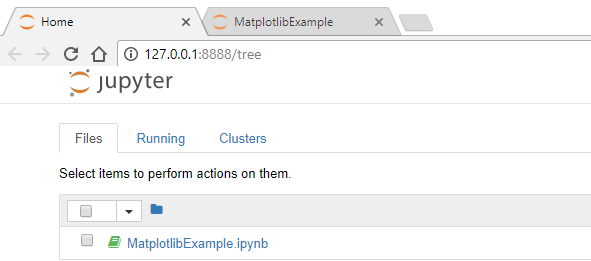
Actually, that's it... From now on you are ready to work with the notebook integration.
Working with cells
First of all, add the following import statement:
from pylab import *This how it's done. To create the next empty cell, click ![]() on the toolbar:
on the toolbar:
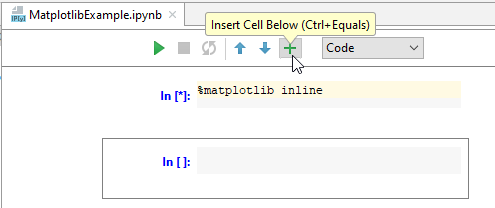
Start typing in this cell, and notice code completion:
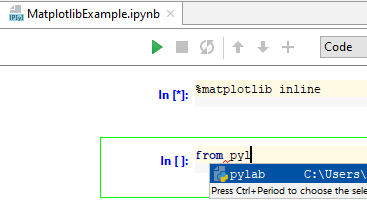
Click ![]() on the toolbar again to run this cell. Note that the cell produces no output, but the next empty cell is created automatically. In this new cell, enter the following code:
on the toolbar again to run this cell. Note that the cell produces no output, but the next empty cell is created automatically. In this new cell, enter the following code:
figure()
plot(x, y, 'r')
xlabel('x')
ylabel('y')
title('title')
show()Run this cell. Oops! The attempt to run results in an error:
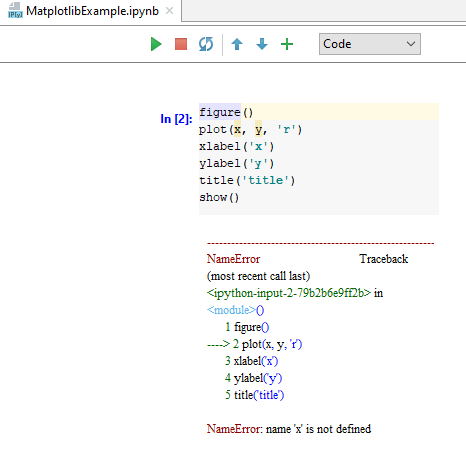
It seems that the variables should be defined first. To do that, add a new cell.
Adding
Since the new cell is added below the current one, click the cell with import statement - its frame becomes green. Then on the toolbar click ![]() (or press Alt+Insert) .
(or press Alt+Insert) .
In the created cell, type the import statements and run them:

The new cell is created automalically. In this cell, type the following code that will define x and y variables:
x = linspace(0, 5, 10)
y = x ** 2Run this cell, and then run the next one. This time it shows the expected output:
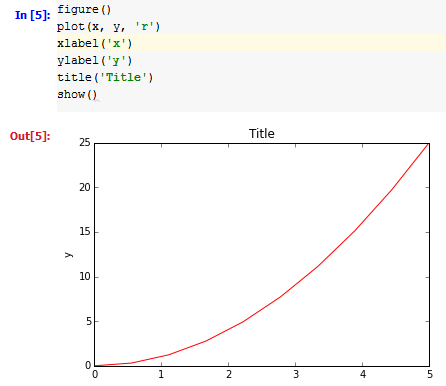
Clipboard operations with the cells
You can perform the standard clipboard operations: Ctrl+C, Ctrl+X and Ctrl+V.
Try these shortcuts yourself.
Running and stopping kernels
As you've already learnt, the button ![]() is used to execute a cell.
is used to execute a cell.
If calculation of a certain cell takes too much time, you can always stop it. To do that, click ![]() on the document toolbar.
on the document toolbar.
Finally, you can rerun the kernel by clicking ![]() on the document toolbar.
on the document toolbar.
The messages about all these actions show up in the console:

Choosing style
Look at the drop-down list to the right of the document toolbar. It allows you to choose presentation style of a cell. For example, the existing cells are presented as code.
Click the cell with the import statement again, and then click ![]() . The new cell appears below. By default, its style selector shows
. The new cell appears below. By default, its style selector shows Code. In this cell, type the following text:
plot exampleRun this cell and see the error message. Next, click the down arrow, and choose Markdown from the list. The cell changes its view:
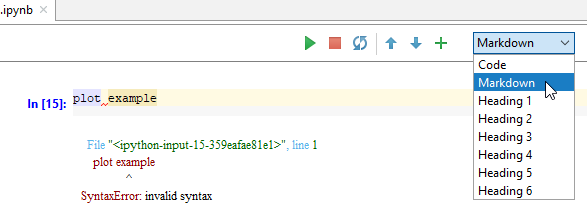
Now click ![]() on the toolbar, and how the cell looks now:
on the toolbar, and how the cell looks now:
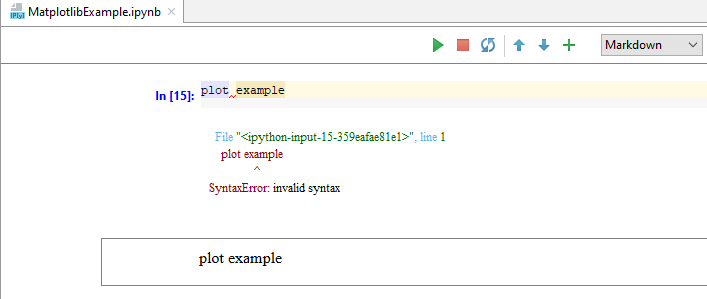
Now you can just select the desired style from the drop-down list, and the view of the cell changes appropriately:
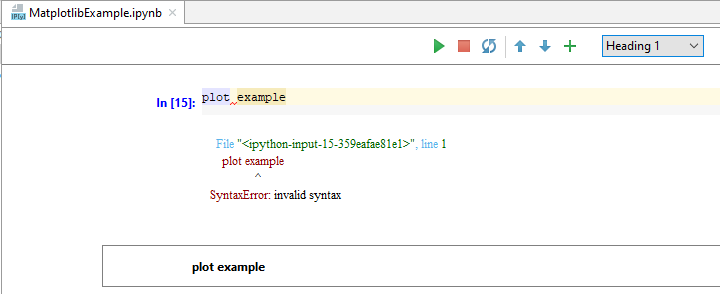
Writing formulae
Add a new cell. In this cell, choose Markdown from the style selector, and type the following text:
$$c = \sqrt{a^2 + b^2}$$Click ![]() . The result is stunning:
. The result is stunning:

As you see, PyCharm's Jupyter Notebook integration makes it possible to use LaTex notation and render formulae, labels and text.
Next, explore the more complicated case. The expected result - the formula - should appear as the result of calculation. Add a cell and type the following code (taken from SymPy: Open Source Symbolic Mathematics):
from __future__ import division
from IPython.display import display
from sympy.interactive import printing
printing.init_printing(use_latex='mathjax')
import sympy as sym
from sympy import *
x, y, z = symbols("x y z")
k, m, n = symbols("k m n", integer=True)
f, g, h = map(Function, 'fgh')Run this cell. It gives no output. Next, add another cell and type the following:
Rational(3,2)*pi + exp(I*x) / (x**2 + y)Click ![]() and enjoy:
and enjoy:
